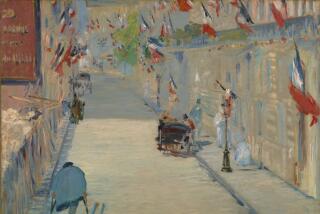ART REVIEW : ‘PARIS 1937’ OFFERS A TASTE OF THE TIME
PARIS — Fifty years is only a blip on the time line of this history conscious city, but it’s an enormous leap in the development of modern art. A half-century also marks the time since Paris staged an enormous exhibition of modern art for its sixth and last international exposition.
No mere carnival or trade fair, the 1937 “International Exposition of Arts and Technology in Modern Life” included major cultural programs and prompted construction of such imposing buildings as the Chaillot Palace and the municipal Museum of Modern Art (housed in the Palace of Tokyo). Little wonder that the affair attracted 32 million visitors and that it has not been forgotten.
Certainly not by the Museum of Modern Art’s curators who decided to celebrate the Expo’s anniversary and the museum’s birthday by organizing an appropriate exhibition. “Paris 1937: L’Art Independant” (through Aug. 30) is a re-creation of the Expo’s major show of French modern art.
The original, called “Masters of Independent Art,” was a huge display that filled the entire Petit Palace with nearly 1,500 paintings and sculptures. The substantial looking sequel is pared down to 353 works. While the list of 120 artists is intact in “Paris 1937,” Matisse’s original 61 works have been trimmed to 11, Maillol’s 61 to 4, Bonnard’s 33 to 6, Picasso’s 32 to 9.
We have to wonder what is missing (the catalogue doesn’t specify) while admitting that editing was necessary. Sixty-one Matisses might have been wonderful, but one maudlin clown face by Francis Picabia is enough and seven examples of Maria Blanchard’s egregious blend of Cubism and Social Realism are too many. Resurrecting larger numbers of, say, Pierre Laprade’s sentimental portraits or Henri de Waroquier’s airless landscapes would not do the artists a service.
Uneven as it is, “Paris 1937” is mainly of interest as a reflection of the orginal show and of curatorial taste of the time. There would be no point in restaging it on the basis of current opinion. We learn less, for example, from admiring the show’s familiar survey of Picasso up to 1932 and from being reminded that Chagall’s enchanted early work was clearly his best than from noting that lesser-known artists Andre Lhote, Albert Gleizes and Roger de la Fresnaye also had moments when expressive spirit was matched by technical achievement. All three are represented by masterful, complex scenes that view figures through Cubist space.
The exhibition suggests that variety was tolerated, even encouraged, in 1937 as long as the subject was easily discernible and not too bizarre. Even in its trimmed-down form, the show accommodates sensibilities ranging from Francois Pompon’s big, dumb bronze bull and Antoine Bourdelle’s heroic “Dying Centaur” to Expressionistic portraits by Chaim Soutine and Fernand Leger’s bracing visions of the machine age.
Amid this array, there’s a notable lack of pure abstraction and Surrealism--apparently due to curatorial preference and to restrictions of nationality and date. (Original guidelines accepted only works made between 1895 and 1925, but several pieces from the ‘30s found their way into the show.)
The obvious strength of “Paris 1937” is Cubism. Its creators, Picasso and Braque, are here with the sort of still lifes that shook up spatial perceptions so profoundly that they have yet to settle down. In this exhibition we see their influence in paintings ranging from Robert Delaunay’s orchestrations of faceted windows to Juan Gris’ authoritative still lifes. Cubism’s influence also reverberates through the sculpture of Henri Laurens, Jacques Lipchitz and Ossip Zadkine.
Offering a picture of art that’s neither complete nor up to date, “Paris 1937” recalls a yeasty period even as it signals the end of a great city’s dominance of the international contemporary art scene. New York took charge after World War II, with the help of European immigrants, but there’s still no place like Paris for remembering the past.
More to Read
The biggest entertainment stories
Get our big stories about Hollywood, film, television, music, arts, culture and more right in your inbox as soon as they publish.
You may occasionally receive promotional content from the Los Angeles Times.










